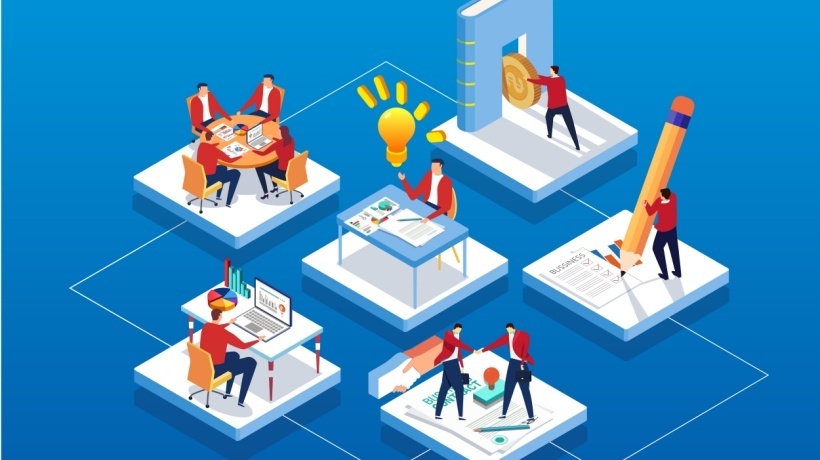Advice To Learn At Work You Won't Find Elsewhere
Continuous learning plays a fundamental part in the long-lasting success of the world’s most influential companies. Take Amazon, Apple, or Pixar for example. These companies are learning machines—their cultures are built on a foundation of learning.
Learning is what helps employees reach their full potential; it’s what keeps them motivated, engaged, and inspired by their own upward trajectory.
If you haven’t heard of LIFOW, here’s the rundown: learning in the flow of work is a concept born from both the necessity for continuous learning and the difficulty of doing so in demanding and fast-paced work environments.
Technology has propelled learning at work far beyond the CD-ROM-based training and primitive Learning Management Systems of the past. LIFOW today means harnessing the powers of learning software and collaborating with colleagues to find instant support, retain relevant information, and become more knowledgeable and capable employees.
Employees are already self-motivated to learn. Those who are proactive with their own learning benefit from increased productivity, lower stress, and genuine satisfaction with the process and outcomes of successfully learning in the flow of work.
Learning becomes part and parcel of work itself with accessible tech designed for learning and collaboration among teams to master relevant skills. This is the key to a healthy and sustainable learning culture.
Keep reading to find 3 pieces of advice for learning in the flow of work that you might not find elsewhere.
LIFOW: 3 Clever Methods
1. Manage Energy, Not Time
You’ve likely heard of the Pomodoro technique, a time management strategy for parsing work into intervals, traditionally 25 minutes in length, separated by short breaks.
The Pomodoro technique can be a helpful way to structure your learning sessions, but it’s not the be-all, end-all of time management.
It’s more important to manage energy than it is to manage time. Time and energy are finite resources, but energy is what allows you to use time effectively. You can always find additional pockets of time in your day, but if you’re mentally and physically exhausted, learning will be difficult, if not downright impossible.

Ryan Snaadt/Unsplash
The next time someone commits to a learning initiative, instead of setting a timer for 25 minutes, have them commit to learning something and then take a break when they start to feel their energy waning. This could be after 10 minutes; it could be after two hours.
The goal is to push just to the point of diminishing returns, and then take a break before energy levels dip too low. This learning strategy helps employees be more productive in shorter bursts and prevent burnout.
Practices like these make it very clear to see where people feel energized, and more importantly, where they do not. Encourage your teams to observe the ebb and flow of their own energy throughout their workday, workweek, and over the course of long-term projects.
Have candid conversations about what gave them energy and what took energy away, and you’ll be able to help them map their energy over those timescales. Then, together, you can start to rebuild their workflows around a job and cadence that maximizes their energy, instead of trying to fill every moment of their time on the clock.
Optimizing for time is a one-way ticket to frustration, stress, and burnout. Optimize for energy to make learning a part of everyone’s daily routine.
2. Teach What You Don’t Know
…Yet.
One of the best ways to learn something is to teach it to someone else. Teacher training programs often use this method, but it’s just as effective for anyone looking to learn something new.
When you’re teaching, you’re forced to organize your thoughts and explain things in a way that’s easy to understand. This process helps you identify gaps in your own understanding and knowledge, which you can then fill by doing additional research or learning on your own.
This learning strategy forces you to confront imposter syndrome head-on. If you’re worried about not being “qualified” to teach someone else something, that’s a sign that you need to learn more about the topic yourself.
But teaching itself can help expose those gaps in your knowledge if you’re brave enough to be corrected.

Headway/Unsplash
There is someone in your company who has the exact knowledge someone else needs.
Create opportunities for newcomers to share their working knowledge of a business function with your in-house experts. Worst case: the experts show the teacher the errors in their ways, and everyone benefits from the exercise. Best case: the newcomer teaches the experts something new or revolutionary, and your company takes a great leap forward.
Experts can teach newbies, and experts can teach each other, but think about how your newest and entry-level employees might be able to shed new light on topics your veteran team members might have overlooked.
If you bake human connection and peer-to-peer teaching into your learning initiatives, your teams can perform better than ever before.
3. Individual And Cohort Learning
At Curious Lion, we champion cohort learning experiences as a highly effective means of transforming teams into learning machines.
But within the everyday grind of work, sometimes it’s infeasible to have a breakout session, group meeting, or cohort-based course to learn what’s needed to get things done. Google is often your best friend.
It’s important to find opportunities for deep exploration of what is interesting and relevant to you personally. To solidify that knowledge, though, it’s wise to share with a colleague, present findings to your team when you find a solution or something remarkable, and/or use manufactured discussion spaces so that the learner won’t forget.

Priscilla Du Preez/Unsplash
Doing so creates learning leaders out of employees; they can showcase their ability to learn on an individual level and then bring everyone up a level by sharing their in-the-flow learning and helping others hold on to new information for the long term.
Cohorts help to find the others along the same learning journey. They’re excellent for maintaining accountability, synthesizing learning by bouncing ideas off one another, connecting deeply on emotional levels with teams, and realizing that learning has been happening all the while even if it didn’t feel like it when people were researching and studying all by their lonesome.
Concluding Thoughts
Learning in the flow of work is essential for companies to keep up with the ever-changing demands of the modern workplace and become learning machines.
You’ll set yourself and your team up for lasting success by managing energy and not time, teaching what you don’t know yet, and harnessing the power of individual and cohort learning.
What are your thoughts on learning in the flow of work? Start a discussion with your colleagues, friends, or family about it.
And if you’re looking for more tips on creating a strong workplace culture, check out our blog. We write about this stuff all the time.









